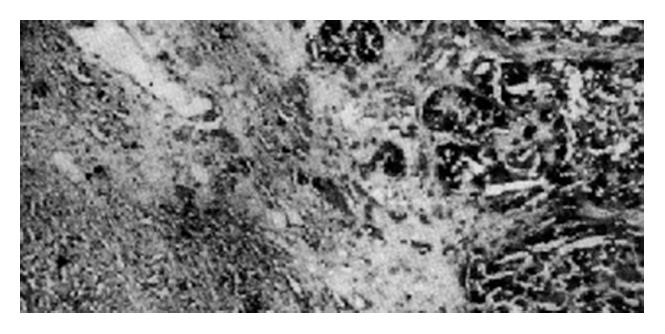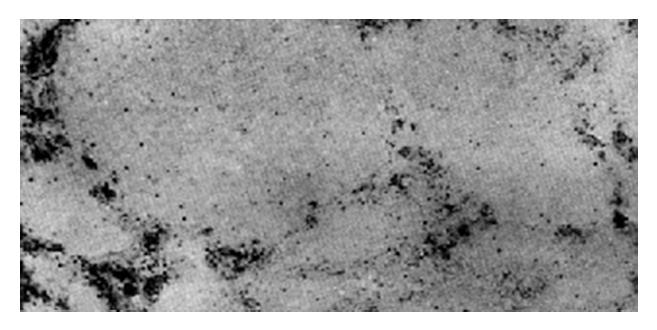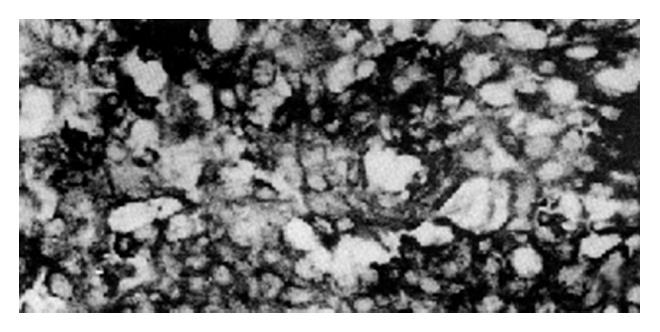Published online Dec 15, 1996. doi: 10.3748/wjg.v2.i4.218
Revised: August 8, 1996
Accepted: October 8, 1996
Published online: December 15, 1996
AIM: To investigate the relationship between the expression of nm23-Hi mRNA and the metastatic potential of hepatocellular carcinoma (HCC).
METHODS: The expression of nm23-H1 mRNA was detected in 24 cases of HCC by in situ hybridization using digoxigenin-labeled nm23-H1 antisense cRNA probe. Twenty-four HCC specimens were divided into two groups according to the following criteria: (1) metastasis in portal lymph nodes; (2) the number of tumors in the liver; (3) cancerous emboli in the portal vein; and (4) the existence of satellite lesions. We named those meeting criteria (1) or (2) and (3), or (3) and (4) high metastatic potential (n = 6); and the others formed the low metastatic potential group (n = 18).
RESULTS: Positive results of in situ hybridization showed granules or masses in the cytoplasm. In the low metastatic potential group strong staining was obtained in ten specimens, while in the high metastatic potential group there was none. Three negative results were found in the high metastatic potential group, and one in the low metastatic potential group (P < 0.05). The expression of nm23-H1 mRNA was not correlated with some clinical factors, such as tumor size or the background liver disease.
CONCLUSION: The expression of nm23-H1 mRNA is inversely correlated with HCC metastatic potential, and can be considered as an index which indicates the metastatic potential of HCC.
- Citation: Chen XD, Dai YM, Yang JM, Bao JZ, Wang JJ, Chong WM. Expression of metastasis suppressor gene nm23 in human hepatocellular carcinoma. World J Gastroenterol 1996; 2(4): 218-219
- URL: https://www.wjgnet.com/1007-9327/full/v2/i4/218.htm
- DOI: https://dx.doi.org/10.3748/wjg.v2.i4.218
nm23, a novel gene associated with low tumor metastatic potential, was isolated from a cDNA library of murine melanoma cells by Steeg et al[1] in 1988. Since then, a large number of investigations have been made by various methods. Although many studies have demonstrated that the nm23 gene is differentially expressed in tumors with different metastatic potential[2-5]. Some researchers still have different viewpoints[6,7]. This preliminary study was designed to investigate the relationship between the expression of nm23-H1 mRNA and the metastatic potential of human hepatocellular carcinoma (HCC).
Twenty-four HCC specimens were obtained from the patients by operation. All the specimens contained cancer tissues and non-cancerous tissues. We divided the specimens into two groups according to the following criteria: (1) metastasis in portal lymph nodes; (2) ≥ 2 tumors in the liver; (3) cancerous emboli in the portal vein; and (4) the existence of satellite lesions. We named those meeting the criteria (1) or (2) and (3), or (3) and (4) high metastatic potential (n = 6); and the others formed the low metastatic potential group (n = 18). Nm23-H1 cDNA was obtained as a gift from Rosengard. Dig-RNA labeling kits were purchased from Boehringer Mannheim Co., and nm23-H1 cRNA probes were prepared according to the manufacturer′s instructions.
In situ hybridization method was derived from several published papers with some modifications[8,9]. Frozen sections were fixed in 4% paraformaldehyde/PBS for 30 min at 4 °C and then rinsed sequentially with PBS, glycine/PBS, and Triton X-100/PBS. Hybridization buffer contained 2 ng/μL nm23-H1 cRNA probes and the sections were hybridized in a 25 μL system. Optimal hybridization temperature was about 50 °C. As a negative control, the sections were hybridized with the sense probe or incubated with hybridization buffer only. To confirm the reactivity of the probes to tissue RNAs, the sections were digested with RNase (100 μL/mL) at 37 °C before hybridization. Statistical analyses were conducted by Ridit test. Results were considered significantly different when P-values were less than 0.05.
The positive results of in situ hybridization showed blue granules or masses in the cytoplasm. Staining intensity was graded as follows: (-), staining less intense than in adjacent non-tumorous tissue; (+), staining intensity similar to or slightly more intense than that in adjacent non-tumorous tissue; (++), staining more intense than in adjacent non-tumorous tissue (Figure 1, Figure 2, Figure 3). The results are shown in Table 1 and Table 2. The nm23-H1 mRNA expression in the high metastatic potential group differed significantly from that of the low metastatic potential group (P < 0.05).
| Staining intensity | |||
| - | + | ++ | |
| Low metastatic potential group | 1 | 7 | 10 |
| High metastatic potential group | 3 | 3 | 0 |
| Staining intensity | |||
| - | + | ++ | |
| Liver tumor (s) | |||
| Solitary | 1 | 9 | 10 |
| Multiple | 3 | 1 | 0 |
| Tumor size (cm) | |||
| ≤ 5 | 3 | 3 | 4 |
| > 5 | 2 | 5 | 7 |
| Associated liver disease | |||
| Chronic hepatitis | 1 | 2 | 5 |
| Liver cirrhosis | 6 | 5 | 11 |
| Serum alpha-fetoprotein (ng/mL) | |||
| ≤ 100 | 2 | 6 | 7 |
| > 100, ≤ 1000 | 2 | 3 | 3 |
| > 1000, ≤ 10000 | 0 | 1 | 0 |
Many investigations have demonstrated that the nm23 gene is closely related with tumor metastasis[4]. It has been widely accepted that nm23 is the best candidate for a metastasis suppressor gene. The results of this study also showed that the expression of nm23-H1 mRNA was inversely correlated with HCC metastatic potential. Rosengard found that nm23 protein existed in the cytoplasm and nucleus, but did not explain the specific functions of nm23 protein in different sites. Our study indicated that nm23-H1 mRNA expression mainly existed in the cytoplasm. Nm23-H1 cDNA probe was used in our study. Labeling kits used were DIG-DNA Labeling and Detecting kits (Boehringer Mannheim). The results of using nm23-H1 cDNA are far from satisfaction. Possible reasons may be: (1) the sensitivity of detecting mRNA using cDNA probe is low; and (2) the quantity of nm23-H1 mRNA is very small. In conclusion, our study shows an inverse relationship between the expression of nm23-H1 mRNA and the metastatic potential of human HCC. The results of this paper warrant further studies with more cases and more detailed clinical features of each case. Our current efforts are focused on the detection of NDPA-A subunit, a product of nm23-H1 gene, whose relationship with HCC metastasis deserves further studies.
This paper was reported at two conferences, namely, the Shanghai International Hepatitis & Hepatocarcinoma Symposium in March 1993, and the Tai Yun 2nd National New Gastroenterology Symposium in June 1996.
Original title:
S- Editor: Yang ZD L- Editor: Wang TQ E- Editor: Zhang FF
| 1. | Steeg PS, Bevilacqua G, Kopper L, Thorgeirsson UP, Talmadge JE, Liotta LA, Sobel ME. Evidence for a novel gene associated with low tumor metastatic potential. J Natl Cancer Inst. 1988;80:200-204. [RCA] [PubMed] [DOI] [Full Text] [Cited by in Crossref: 949] [Cited by in RCA: 992] [Article Influence: 26.8] [Reference Citation Analysis (0)] |
| 2. | Tokunaga Y, Urano T, Furukawa K, Kondo H, Kanematsu T, Shiku H. Reduced expression of nm23-H1, but not of nm23-H2, is concordant with the frequency of lymph-node metastasis of human breast cancer. Int J Cancer. 1993;55:66-71. [RCA] [PubMed] [DOI] [Full Text] [Cited by in Crossref: 81] [Cited by in RCA: 97] [Article Influence: 3.0] [Reference Citation Analysis (0)] |
| 3. | Nakayama T, Ohtsuru A, Nakao K, Shima M, Nakata K, Watanabe K, Ishii N, Kimura N, Nagataki S. Expression in human hepatocellular carcinoma of nucleoside diphosphate kinase, a homologue of the nm23 gene product. J Natl Cancer Inst. 1992;84:1349-1354. [RCA] [PubMed] [DOI] [Full Text] [Cited by in Crossref: 104] [Cited by in RCA: 111] [Article Influence: 3.4] [Reference Citation Analysis (0)] |
| 4. | Hennessy C, Henry JA, May FE, Westley BR, Angus B, Lennard TW. Expression of the antimetastatic gene nm23 in human breast cancer: an association with good prognosis. J Natl Cancer Inst. 1991;83:281-285. [RCA] [PubMed] [DOI] [Full Text] [Cited by in Crossref: 195] [Cited by in RCA: 218] [Article Influence: 6.4] [Reference Citation Analysis (0)] |
| 5. | Boix L, Bruix J, Campo E, Sole M, Castells A, Fuster J, Rivera F, Cardesa A, Rodes J. nm23-H1 expression and disease recurrence after surgical resection of small hepatocellular carcinoma. Gastroenterology. 1994;107:486-491. [PubMed] |
| 6. | Higashiyama M, Doi O, Yokouchi H, Kodama K, Nakamori S, Tateishi R, Kimura N. Immunohistochemical analysis of nm23 gene product/NDP kinase expression in pulmonary adenocarcinoma: lack of prognostic value. Br J Cancer. 1992;66:533-536. [RCA] [PubMed] [DOI] [Full Text] [Full Text (PDF)] [Cited by in Crossref: 44] [Cited by in RCA: 54] [Article Influence: 1.6] [Reference Citation Analysis (0)] |
| 7. | Royds JA, Rees RC, Stephenson TJ. nm23--a metastasis suppressor gene? J Pathol. 1994;173:211-212. [RCA] [PubMed] [DOI] [Full Text] [Cited by in Crossref: 17] [Cited by in RCA: 19] [Article Influence: 0.6] [Reference Citation Analysis (0)] |
| 8. | Su HC. In situ hybridization. Beijing: China Science and Technology Press 1994; 59-90. |
| 9. | Fiorentino M, Grigioni WF, Baccarini P, D’Errico A, De Mitri MS, Pisi E, Mancini AM. Different in situ expression of insulin-like growth factor type II in hepatocellular carcinoma. An in situ hybridization and immunohistochemical study. Diagn Mol Pathol. 1994;3:59-65. [RCA] [PubMed] [DOI] [Full Text] [Cited by in Crossref: 15] [Cited by in RCA: 18] [Article Influence: 0.6] [Reference Citation Analysis (0)] |











